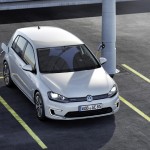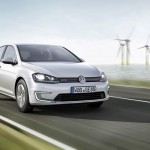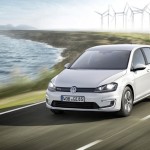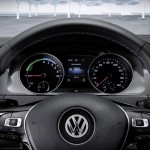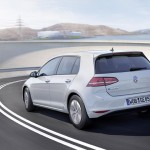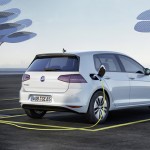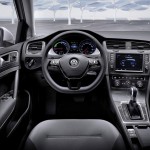In a double premiere at the International Motor Show (IAA) in Frankfurt am Main (10th to 22nd September) Volkswagen will be unveiling two new and extremely efficient electric cars: the e-up! and the e-Golf. The German carmaker is thus transferring two full-production bestsellers into the era of electric mobility. Both zero-emission cars are perfect for everyday use, four-door models in all cases and fully equipped. They include these standard features: automatic climate control, remote controlled parking heating/ventilation (air conditioning and heating), radio-navigation system, heated windscreen, alloy wheels, LED daytime running lights and in the case of the e-Golf all-LED headlights. They also lead the way in efficiency: in travelling 100 kilometres, the e-up! consumes just 11.7 kWh of power, making it the efficiency world champion, as no rival matches this figure. Two classes larger, the e-Golf also achieves an excellent figure of 12.7 kWh/100 km1. The result is that driving 100 km in the e-up! costs only €3.022 and with the e-Golf €3.282.
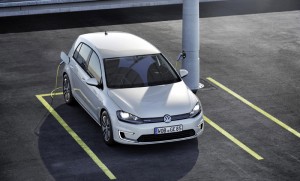
Silently dynamic. Despite their great efficiency both the e-Golf and the e-up! produce a practically sporty level of performance. Even as cars with conventional drive systems both these Volkswagen models already have superior suspension. As a result of the low centre of gravity of the batteries integrated in space-saving manner within the car floor, the handling now becomes even crisper. Both newcomers also profit from a specific dynamic characteristic of electric cars: the practically silent electric motors generate a level of starting torque from standstill that is otherwise experienced only in cars of much greater horsepower. The motors, gearboxes and batteries of the e-up! and e-Golf are in-house developments, produced in German Volkswagen components plants.
e-Golf facts and figures. The e-Golf, one of a number of cars making its world premiere in Frankfurt, is powered by an 85 kW1 / 115 PS1 electric motor. Like the motor in the e-up! it achieves speeds of up to 12,000 rpm and makes its maximum starting torque of 270 Nm available right from the off. The result is that the front-wheel drive e-Golf reaches 100 km/h in 10.4 seconds. On motorways the top speed of the five-seat Volkswagen is electronically limited to 140 km/h.
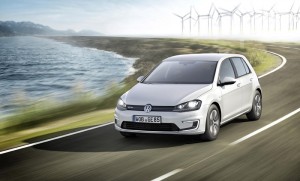
e-up! facts and figures. The e-up! is also making its public debut at the IAA. Its electric motor – as in the e-Golf a synchronous motor – produces 60 kW / 82 PS. Right from a standing start it thrusts 210 Nm onto the powered front axle. The four-seater achieves the sprint up to 60 km/h in 4.9 seconds and reaches 100 km/h within 12.4 seconds. Top speed: 130 km/h.
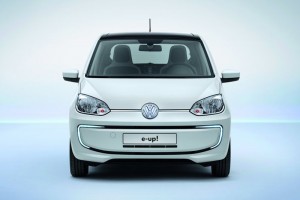
Range levels tailored to commuters. From a single battery charge (18.7 kWh) the e-up! has a range of up to 160 km, while for the e-Golf, due to its larger battery (24.2 kWh), the figure is up to 190 km1. In both models three intuitive driving modes (‘Normal’, ‘Eco’ and ‘Eco+’) and four equally easy to activate levels of regenerative braking (‘D1’, ‘D2’, ‘D3’ and ‘B’) help drivers to get the maximum range out of each charge. Worth noting: research by Germany’s Federal Ministry of Transport, Building and Urban Development found that around 80 per cent of all car drivers in the country, from commuters to motorists making lots of journeys, drive less than 50 kilometres a day.
Powertrain and fuel strategy. Volkswagen set out its roadmap for the future and thus also the starting point for electric vehicles such as the e-up! and e-Golf back in the past decade with a structured powertrain and fuel strategy. This strategy assigns realistic timeframes to the introduction of new, alternative drive systems, such as hybrid, electric and hydrogen. In addition, Volkswagen has made it the company’s aim to establish the brand as market leader in e-mobility (as in other areas) by 2018.
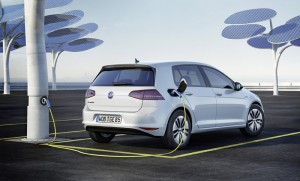
2013 is a key year for electric mobility. In the future Volkswagen will continue to rely on an intelligent mix of the most efficient drive systems. In this respect, battery electric systems – as will be shown by the new e-up! and the e-Golf – are both a sensible and essential addition. The reasons for this are obvious: first, electric vehicles enable large-scale utilisation of renewable energy sources (wind, solar, hydro) to power automobiles. For example, when it launches the e-up! in Germany this autumn, Volkswagen will be offering the ideal electrical power for the car (“BluePower”). This energy, generated without CO2 emissions, comes exclusively from hydro-electric generating plants in Germany, Austria and Switzerland. Supply and sales partners are the German company LichtBlick SE and the Volkswagen Bank. Electric cars also offer emissions relief to metropolitan areas based on their drive technology which always features zero local emissions. Furthermore, Volkswagen’s electric vehicles are also a genuine alternative as, in terms of efficiency and recycling their battery technology, they are fully compatible with the requirements of high volume production. All drive system factors are thus now perfectly set for e-mobility to really take off. Within the framework of the company’s powertrain and fuel strategy, Volkswagen will therefore, as mentioned above, be pushing forward in parallel with the introduction of new hybrid models. The Jetta Hybrid BlueMotion and the Touareg Hybrid BlueMotion are already in the model range. The next model of this kind due to follow next year is a Golf plug-in hybrid, which, in contrast to the standard hybrid, can also cover longer distances (50 km) solely on electric power thanks to a battery (with greater capacity) that can be charged from an external power source. Volkswagen will in addition continue to enhance its efficient petrol, diesel and gas engines (TDI, TSI, TGI), as these drive technologies will coexist long into the future.
In time with big city life. The fact is that the target group for electric cars is growing, as a paradigm change has begun. A core focus of social behaviour is increasingly on sustainable mobility. But the products for putting this environmental awareness into action need to be suitable and enjoyable, like the e-up! and e-Golf, which accelerate up to the tempo of big city life in just a few seconds. The new zero-emission Volkswagens therefore have the potential to charge the electric car segment with innovative engineering, great everyday practicality and a dynamic feeling.
Source; Volkswagen
